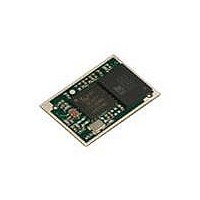DVK-BTM411 Laird Technologies, DVK-BTM411 Datasheet - Page 17

DVK-BTM411
Manufacturer Part Number
DVK-BTM411
Description
BLUETOOTH EVAL BOARD BTM411
Manufacturer
Laird Technologies
Type
Transceiverr
Specifications of DVK-BTM411
Frequency
2.4GHz
Wireless Frequency
2.402 GHz to 2.48 GHz
Interface Type
UART
Data Rate
2.1 Mbps
Operating Voltage
3 V to 3.3 V
Antenna
Multilayer Ceramic Integrated
Operating Temperature Range
- 30 C to + 70 C
Output Power
4 dBm
Technology/ Type
Development Kit
For Use With/related Products
BTM411
Lead Free Status / RoHS Status
Lead free / RoHS Compliant
Lead Free Status / RoHS Status
Lead free / RoHS Compliant, Lead free / RoHS Compliant
Other names
DVK-BTM411
Available stocks
Company
Part Number
Manufacturer
Quantity
Price
Company:
Part Number:
DVK-BTM411-02
Manufacturer:
LAIRD
Quantity:
2
BTM410/411
Bluetooth
AT COMMAND SET
REFERENCE
17 www.lairdtech.com
®
AT Data Module
General S Registers
Please refer to Appendix, Table 4.1 for a list of supported S Registers.
The main purpose of S Registers is to make the device configuration persistent. All S Registers can be saved to
non-volatile memory by AT&W.
In some cases, an AT command and an S register exist for one and the same setting. In the majority of those
cases the AT command’s setting will be lost on next power cycle whereas the S register can be saved and is still
available after power cycle. This rule applies to many but not to all of those cases.
AT Commands for Inquiry
Field
0 – ADR
1 – COD
2 – FN
3 – RSSI
4 – EIRD
1. AT+BTI<devclass> { Inquire}
This will make the device perform an inquiry for delay seconds and max number of unique responses,
where delay is defined by S register 517 and max is specified by S register 518.
The <devclass> is an optional parameter where the value specifies either a 6 digit device class code or
a 2 digit major device class. If it is not specified, the value is taken from S register 516.
When <devclass> is 6 hexadecimal characters long, it specifies an AND mask which is used to filter
inquiry responses. When <devclass> is 2 hexadecimal characters long, it forces the inquiry to filter
responses to devices that match their major device class code to this value – which can only be in
the range 00 to 1F.
The response format to AT+BTI is defined by S Register 330 by bitmask. This is device address, device
class, friendly name, receiver strength indicator and extended inquiry data. Please refer to Figure 3.1
and Table 3.2.
For S330=1:
Response: <cr,lf>12346789012
<cr,lf>12345678914
<cr,lf>OK<cr,lf>
A Bluetooth inquiry process is such that for a single inquiry request a device could respond many times.
To ensure that an address is sent to the host only once for a particular AT+BTI, an array of addresses is
created at the start of each AT+BTI and is filled as responses come in. This array of addresses is stored
in dynamic memory and as such if the memory allocation fails then the inquiry procedure is aborted and
in that case an error response is sent to the host. To clarify, a single AT+BTI will never return the same
Bluetooth address more than once, but as long as the responding device is active, all AT+BTI commands
will always return it.
As the inquiry process is driven by randomness, it is not guaranteed that each discoverable device is
always found on the first attempt. Sometimes more than one inquiry processes might be necessary
to find a particular device. The probability also depends on the inquiry scanning intervals of the device
being searched for.
The inquiry process can be speed up if the friendly name is not required (flag not set in S330) as part of
the inquiry response or if a <dev_class> filter is used.
Description
1 – display Bluetooth device address on inquiry result
0 – do not display Bluetooth device address on inquiry result; if any further bit is set, a comma is inserted as
separator
1 – display class of device on inquiry result
0 – do not display class of device on inquiry result; if any further bit is set, a comma is inserted as separator
1 – display friendly name on inquiry result
0 – do not display friendly name on inquiry result; if any further bit is set, a comma is inserted as separator
1 – display RSSI value on inquiry result
0 – do not display RSSI value on inquiry result; if any further bit is set, a comma is inserted as separator
1 – display eird on inquiry result
0 – do not display eird on inquiry result
Bit
Default
7
Reserved for future usage
0
Figure 3.1: S Register 330 controlling inquiry response format
Table 3.2: Field Descriptions for S Register 330
6
0
5
0
4
EIRD
0
3
RSSI
0
2
FN
0
1
COD
0
0
ADR
1
Laird Technologies




















